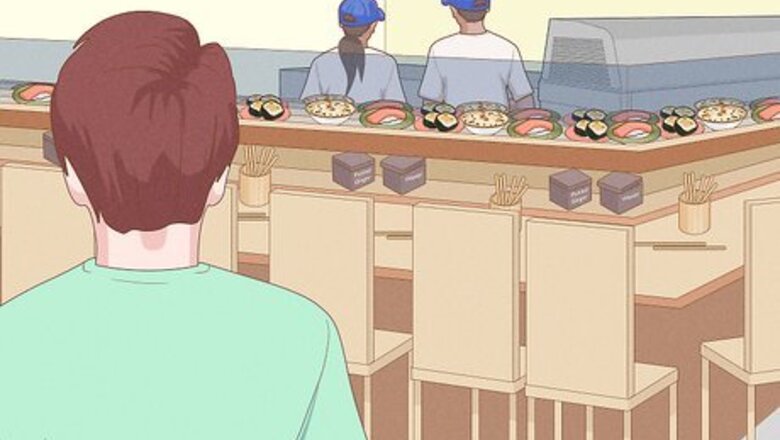
views
Getting Seated and Ready to Eat
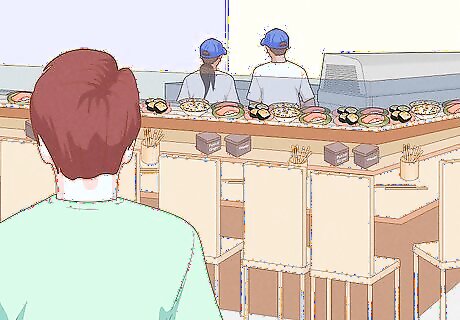
Enter the restaurant and wait to be seated in front of the conveyor belt. Wait in line if there is a line to be seated. Let the host or a server know how many people are in your party and wait for them to seat you. Conveyor belt sushi restaurants typically have bar seating in front of the conveyor belt and sometimes tables for larger parties. The host or server may lead you directly to your seat or give you a number that tells you where to take a seat, depending on the restaurant.
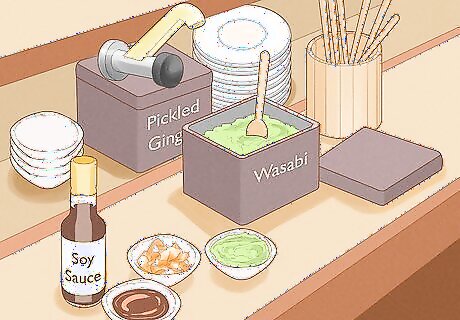
Sit down and help yourself to ginger, soy sauce, and wasabi from nearby. There are usually condiment stations located in front of every seat or two at the bar and at each table. Take 3 small dishes and fill them with soy sauce, ginger, and wasabi from the condiment station closest to your seat. If you don’t see a specific condiment near your seat, such as wasabi, you can always order it from a nearby sushi chef or your server. In case you’re not familiar with eating sushi, the soy sauce is meant for dipping, the ginger is for eating between different plates to cleanse your palette, and wasabi is for adding spiciness. Feel free to skip out on any of the condiments if you prefer not to use them.
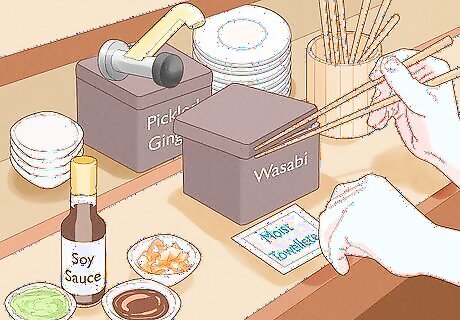
Grab a pair of chopsticks and a moist towelette from nearby as well. These are other items that are typically provided at a station by your seat at conveyor belt sushi restaurants. Take a pair of chopsticks to eat your sushi with and wipe your hands off with the moist towelette before you start eating. If you don’t see chopsticks and a moist towelette station nearby, your server will probably bring them to you instead. If you don’t know how to or prefer not to use chopsticks, you can always ask your server for a fork.
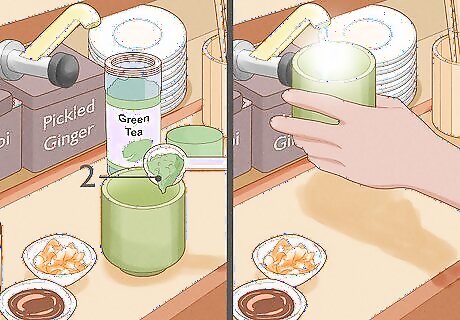
Serve yourself some hot tea if there is a self-serve tea station nearby. There is usually a hot water dispenser, mugs, and powdered green tea near the condiments at conveyor belt sushi restaurants. Take a mug, put 1-2 scoops of the powdered tea in the mug, then fill it up with hot water. If you don’t like or don’t want hot green tea, you can skip this and get something else to drink.
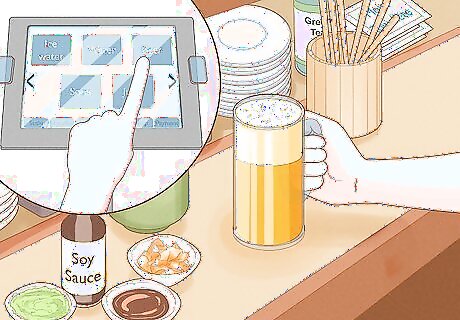
Order any other drinks you want from your server. Check the menu to see what other beverages are available. Flag down your server and order anything off the menu that appeals to you, such as ice water, soda, beer, or sake. There will either already be a menu on the counter or table in front of your seat or your server will hand you one when they seat you. Some conveyor belt sushi restaurants have touch-screen menus at every seat that you can order from. If this is the case, just click on the beverages you want to order and place the order digitally instead of ordering from a waiter.
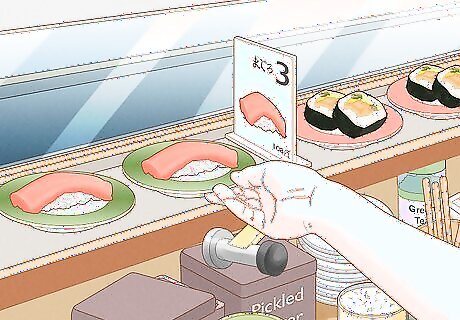
Read the plate key to find out how much each colored plate costs. All the plates that pass by on the conveyor belt are color-coded according to price. Look at the menu to see how much each color costs, so you know how much your bill will go up each time you grab a plate of a certain color. This is especially important if you’re dining on a budget. For example, if blue plates are the cheapest, you’ll know that you can eat more of those.
Choosing Plates and Dining
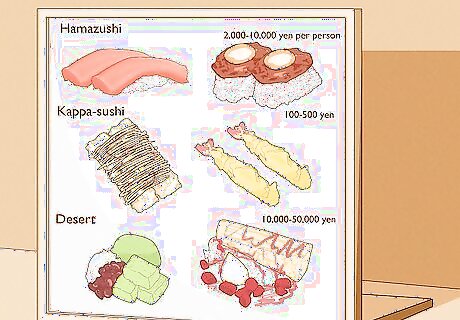
Look at the pictures on the menu to figure out what different dishes look like. The menu will have pictures of the different types of sushi and other dishes along with the name of what they are. Inspect the pictures to find out what different dishes you want to eat look like, so you can snag them as they pass by. For example, nigiri plates typically look like 2 oval-shaped balls of rice with slices of fish on top of them. Salmon nigiri looks like 2 orange slices of fish on top of the rice and tuna nigiri looks like 2 slices of pinkish-red fish on top of the rice. Something like a spicy tuna roll might look like a plate of 6 pieces of rice roll wrapped in seaweed with red tuna in the middle.
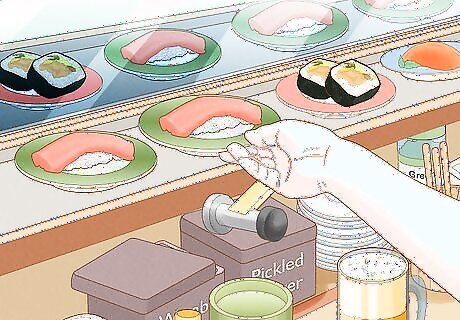
Take plates that you want to eat off the conveyor belt as they pass by. Watch carefully as different dishes pass you by and snap up any that look tasty to you. Don’t be afraid to try new things, even if you don’t know exactly what they are. This is all part of the experience! Make note of any plates that have been around the conveyor belts several times. These will be the least fresh dishes.
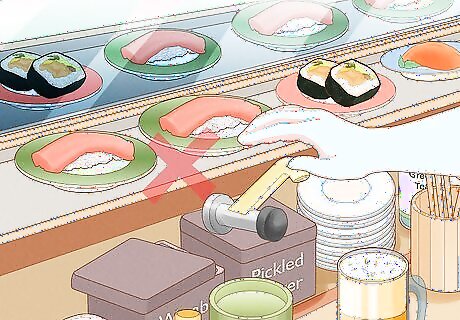
Avoid touching plates you aren’t going to take or putting plates back. Only touch plates when you’re sure you want to eat them. Don’t put a plate back on the belt that you already removed, even if you haven’t touched the food on it. For example, don’t grab a plate to get a closer look at the sushi on it to decide whether you want to eat it. When in doubt about a plate, just let it pass by and decide whether you want it the next time it comes around.
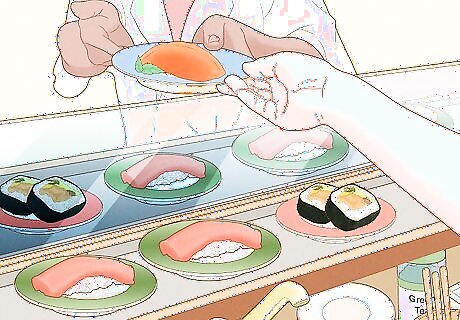
Order anything you don’t see passing by on the belt from a chef or a waiter. Flag down a nearby sushi chef or your server. Ask them to prepare and bring you any dishes on the menu that you aren’t seeing on the conveyor belt. The menu sometimes has things that don’t typically go around on the conveyor belt. For example, there might be bigger noodle dishes or things like miso soup that you can only order off the menu. If the restaurant you’re at has touch-screen menus, you can just order dishes directly through the digital menu instead of from a chef or server. A classically trained sushi chef serves tuna first because tuna is the king of the ocean. Then white fish and salmon. Coloration is also important from the chef's point of view, for example, serving white-colored food with colored food.
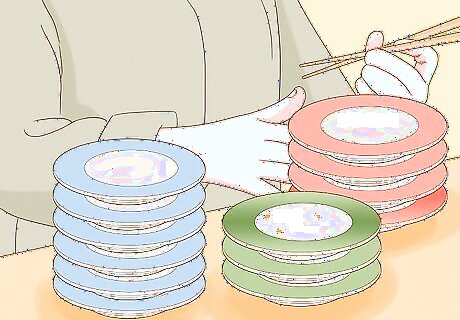
Stack your plates up according to color as you finish them. Make a pile of your plates off to the side of your seat when you finish the food on them. Your server will add up the cost of the plates to give you your bill at the end. Try to keep the same colors together to be courteous and make it easier for your waiter to count the plates of each color. If you’re eating with multiple people and want to get separate checks at the end, make sure each person makes their own stack of plates.
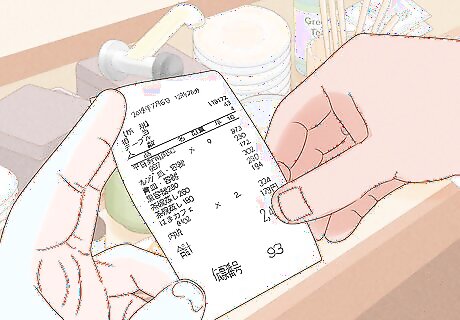
Flag your server down when you’re done eating and ask to pay. Wave or call the waiter over once you’ve had your fill and ask for your bill. Wait for them to count up all your plates and add the total cost to your bill along with anything else you ordered. Depending on the restaurant, you can either pay the waiter directly or take your bill to a cash register and pay.




















Comments
0 comment